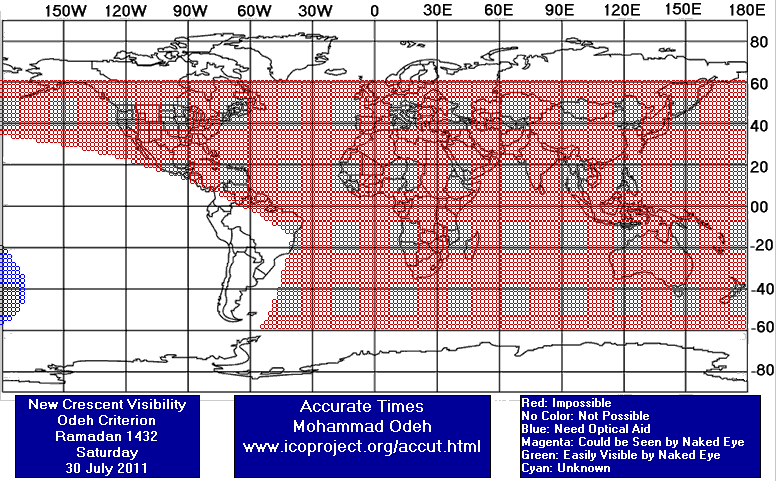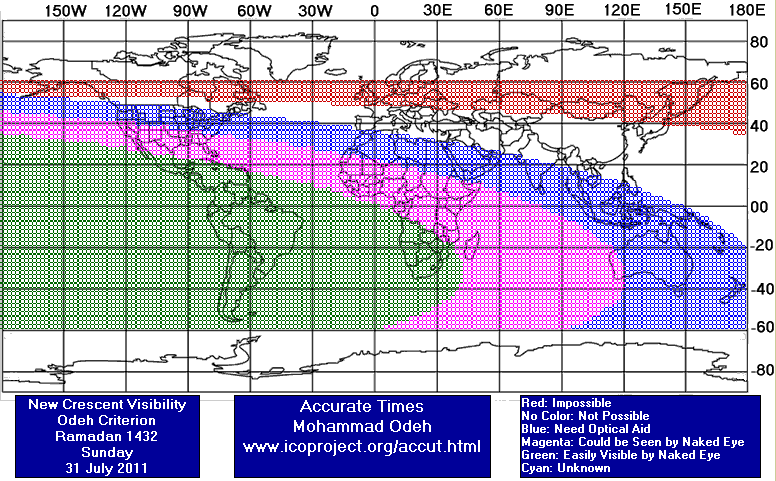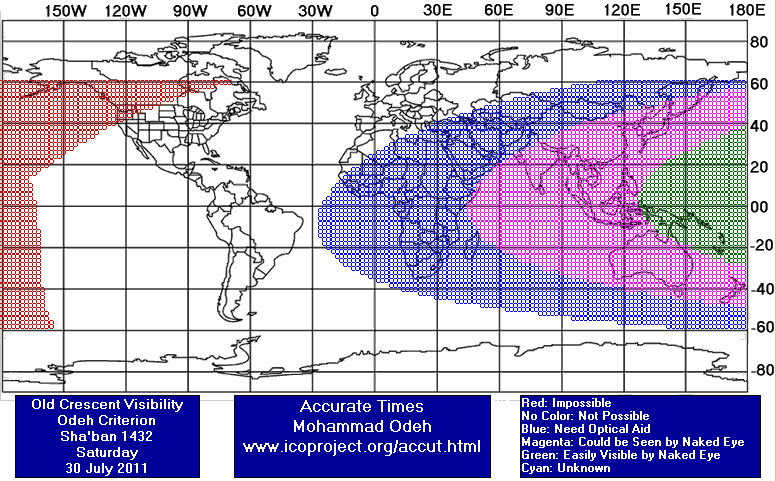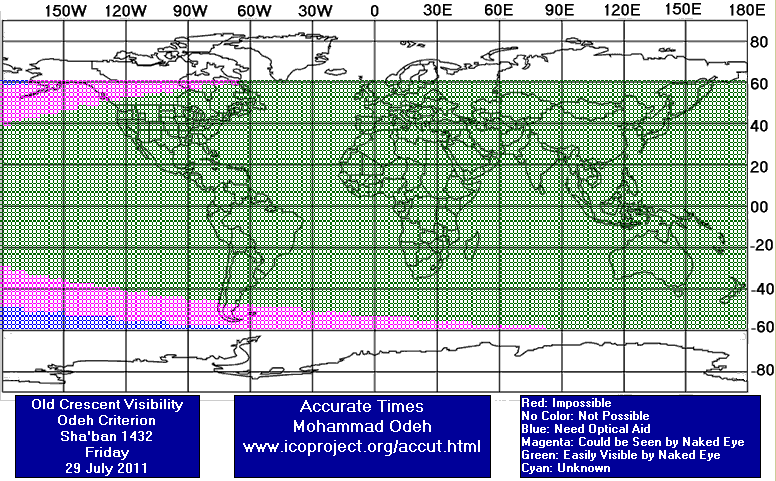Visibility of Ramadan Crescent 1432 AH
- When to Observe Ramadan Waxing (NEW) Crescent ?
- Ramadan Waxing (NEW) Crescent Observation Results
- The OFFICIAL First Day in Different Countries
- When to Observe Sha'ban Waning (OLD) Crescent ?
- Sha'ban Waning (OLD) Crescent Observation Results
When to Observe Ramadan Waxing (NEW) Crescent ?
The geocentric conjunction (Geocentric New Moon) will occur Inshalla on (Saturday 30 July 2011) at 18:40 UT.
Sighting the new crescent on (Saturday 30 July 2011) and (Sunday 31 July 2011) is shown in the below graphs using the program Accurate Times by Mohammad Odeh according to Odeh criterion. Where:-
- It is impossible to see the crescent from the areas located under the red color. Because either the Moon on this day sets before the Sunset and/or the topocentric conjunction occurs after the Sunset.
- The crescent is expected to be seen by optical aid only from the areas located under the blue color.
- The crescent is expected to be seen by optical aid from the areas located under the magenta color. In these areas the crescent could be seen by naked eye if the atmospheric conditions are superb and the observer is experienced.
- The crescent is expected to be easily visible by naked eye from the areas located under the green color.
- The crescent cannot be seen from uncolored areas, even though the Moon sets in these locations after the Sunset and the topocentric conjunction occurs before the Sunset, but the Moon is not sufficiently illuminated in order to be seen as crescent even by optical aid.
- Kindly notice that the below graph shows the possibility of seeing the crescent from areas between 60 degrees north of Equator down to 60 degrees south of Equator.


According to the Universal Hejric Calendar (UHC), which is based on the calculated crescent visibility, the start of this month in the Eastern Region will be on Monday 01 August 2011 and in the Western Region will be on Monday 01 August 2011. Kindly notice that the UHC is a pre-calculated calendar, which adopts a certain criterion to start the new Hejric month. Your country/organization might adopt different criterion to start the new Hejric month. So it is highly advised to read the UHC website before giving any judgment.
- Results of seeing the crescent, and the first day of the month in different countries will be added here Inshalla as we receive the reports from ICOP's members. If you wish to be a member in ICOP, or to know more about it, kindly click here.
Ramadan Waxing (NEW) Crescent Observation Results
Sun 31 July 2011
Algeria
Mr. Hocine Chikh Aissa said: "More than 75 persons were prensent in N'tissa station. Ramadan 1432 crescent was not seen neither by naked eyes nor by binoculars (03) and telescop. Ramadan 1432 Mubarek for all Muslimeen." "
Mr. Omar Tadjrouna said: "رصد هلال رمضان 1432 هـ من منطقة "لنتيسة" [32°28’N، 3°37’E] حوالي 5 كم غرب مدينة غرداية يوم الأحد 29 شعبان 1432 هـ 31 جويلية 2011م. كان البرنامج لفائدة أصدقاء من جماعة "إينارن" (أضواء) للحراسة الليلية بالتنسيق مع نادي "عمي سعيد" لعلم الفلك. اجتمعنا بعين المكان حوالي 30 دقيقة قبل غروب الشمس وكانت السماء صافية والجو حار نوعا ما، حيث جلسنا باتجاه معاكس للشمس لتفادي نورها أثناء الغروب محافظة على قدرة العين على التمييز، حيث قدمت معطيات حول الهلال. ولما أفلت الشمس عند الأفق (تقريبا 0° من عين المكان) اتجهت الأنظار جهة الغرب بعد حصر زاوية الرصد على الدائرة الأرضية. بعد 21 دقيقة من الرصد وهو زمن مكث الهلال في الأفق، لم يتمكن راصدٌ من رؤية الهلال.. لا بالعين المجردة ولا بالمنظار ولا بالتلسكوب.. وكان الجميع يدرك صعوبة الرصد، إذ كان ارتفاع الهلال أقل من 4° (في حدود 3.5°) لحظة الغروب. صلينا المغرب جماعة ثم قُدّم بعدها تقرير العملية لينصرف الجمع على أمل اللقاء في 29 رمضان ليلة الشك. كان عدد الراصدين أكثر من 60 نفرا من أعضاء جماعة إينارن والنادي ومهتمين.. جمعهم الأمر التعبدي الشرعي والفضول ومتعة الرصد. "
Eng. Z-Kacem Bankih said: "More than 20 peoples have tried, from Merkiche station, to observe the Ramadan 1432 crescent but it wasn't seen. We have used some binoculars and the western sky was clear with a fine haze. Ramadan mubarek for all."
Australia
Brunei Darussalam
Dr. Mohammed Hussain Ahmad said: "The new moon was not sighted in Brunei Darussalam today 31st July 2011, therefore 1st Ramadan 1432 will start on Tuesday, 2nd August 2011"
Mr. Hazarry Haji Ali Ahmad said: "Some members of the Astronomical Society of Brunei Darussalam were at Agok Hill but failed to see the 15.6 hour old new moon crescent. The lag time after sunset was about 24 minutes before the moon set. We had some cloudless views in the sky at the position of the moon through the scope, but the cresent was not visible. Ramadhan in this country commences on Tuesday, 2 Aug 2011 and the result of the sighting was officially announced on Radio and Television Brunei."
Iran
Mr. Nima Mossayebi said: "Observers:Nima Mossayebi, Hesam Moradi, Yekta Mohammadi, Hajar Aahmadzadeh (2nd team of Mahtab crescent observation group,Adib astronomy center) - Equipment:one 20*90 and one 20*120 binaculars,GPS, theodolite we were trying to see the moon starting from 14:30 local time until the moon went below horizon at 19:55 "
Mr. Abbas Ahmadian said: "I saw the crescent by 17mm Ultra Wide Angle & three colored filters on this eyepiece! It was seen at daytime from 12:43 to 17:40 LT (Sunset 20:11)! The atmospheric conditions were very nice! I used 10" Dobsonian telescope on the LX200 Meade GOTO mount, and I made the alignment at daytime! I could see Venus, Mercury, Jupiter, Arcturus & Sirius at daytime!The elevation of the site is 3350 meters above sea level."
Eng. Seyyed Ghasem Rostami said: "We started at the 12.00 o'clock. I selected a 40 mm (wide angle view 72 degrees) ocular for 1.44 degrees of view field and magnitude equal to 50. The first I go to Jupiter to determination of GoTo error of Celestron telescope. Then I saw the Venus easily but the Mercury has seen hardly. We could not see the crescent until 17:00. I saw the crescent of Mercury easily at this moment. Immediately I go to the moon and saw its crescent in behind of ocular finally. The crescent was very thin. Mr Ali Omani Saw the crescent also. The last time of sighting of the crescent was 18:15. Because the crescent was near of horizon and the dust did not allow to seen the crescent again. I took several photos by Nokia mobile phone (X6 model) from back of ocular at the 17:10 to 17:13. The crescent detected in one of those that I attach it in this report. "
Jordan
Ms. Basma Dhiab said: "There were 25 persons at the site of the observation, Some of them are ICOP and JAS members in addition to some guests. We were aware that the crescent couldn't be seen ( 3,5 degree above the horizon ), We took the opportunity to observe Saturn using the telescope and to observe the constellation. Our guestst were happy for that ... and there were firework too! Ramadan Mubarak :-)"
Lebanon
Mr. Ibrahim Merhebi said: "Note: Sighting wasn't actually with a binoculars but it was with a Meade finder scope (8x50)."
Malaysia
Mr. Kassim Bahali said: "About 300 people including the hilal observation committee led by Mufti, the Governor and chief minister of Melaka gathered at Al-Khawarizmi Astronomy centre to obseserve hilal of Ramadhan. The hilal was not seen due the western sky was cloudy. I wish to you all Ramadhan Kareem, may Allah accept our doa and fast."
Nigeria
Mr. Qamarudeen Muhammad said: "At about around 8 degree of western horizon was cloudy hence inspite of keen interest show by many people at observation spot new Hilal was never visible and from Information from some individual contact around the country, Hilal was never sighed by them."
Mr. Abdul-Rasaq Abdul-Azeez Ishola said: "Asalam aleikun we tried to look for ramadan crescent today 31-7-11 at jubilee estate area of ikorodu but was not seen due to total cloud of wester horizon. same Report from kaduna,Maiduguri,Ilorin.some of our member with telescope and binoluer were unable to to sight it too at leventis marina. kudos to sulton of sokoto who had courage to rejected the false sighting yesterday when even the moon is still in the east. we appreciates all truth knowledge lovers expecially leage Imams and alfas of south west for their schorlatic understanding.happy ramadan to u all"
Norway
Mr. Milad Ali Ershaghi said: "On Sunday, July 31, 2011 I attempted to sight the new crescent moon of Ramadan from Oslo, Norway. Sunset time was 9:50pm and Moonset was at 9:22pm - before sunset, which made it impossible to see the moon."
Oman
Prof. Mohammed Al-Bussaidi said: "Most of the adjoining areas aound Muscat the western sky was covered by clouds. As such the crescent Moon was not sighted. "
Eng. Martin Elsaesser said: "Clouds and strong haze destroyed all hope to see the difficult crescent. Having arrived late, we could only start to observe when the sun and moon were already very low. Some unexpected problem with the power-supply als hindered our efforts. Lessons learned (hopefully): - choose a good spot and visit it beforehand - arrive early - test all components thoroughly at home before you start, in just the configuration as you plan to use them. test all the steps you will need once on site - good infrastructure (firm ground, power supply, shelter) is more important than a scenic location"
Qatar
Eng. Mohammad Odeh said: "The crescent was seen by CCD imaging only (during daytime). It was not seen by naked eye or telescope. We started our observation by CCD imaging from the Roof of Aljazeera Space Channel at 12:30. I was observing along with my friend Mr. Mohammad Qariesh. At 12:55 we started seeing what we though is the crescent, however, because it was not really clear we couldn't confirm it, so we used several filters and we did several other trials. We always used to get the same shape at approximately the same location and the curve opening is identical to the crescent opening. So we decided to move the telescope to the Moon itself instead of the crescent, so if what we used to see will move to the edge of the photo, then definitely this is the crescent, so at our last attempt we moved the scope to the Moon, and the curve that we used to see moved to the edge of the frame as expected, so definitely it was the crescent. However, with some image processing later on, the crescent was clear in our last attempt. Below are two photos one is for the crescent at 14:17 and the other one at 14:27. Actually the hot weather prevented us from continuing the observation as the temperature was around 44 degrees Celsius!"
Saudi Arabia
Mr. Saleh Al-Saab said: "Happy Ramadhan for you all. The crescent was only (4) degrees above horizon at sunset ,so it was not seen even by any optical aid. "
South Africa
United Kingdom
Eng. Qamar Uddin said: "On Sunday 31 July 2011 (29 Shaban 1432 AH) many people from throughout UK have attempted to sight the crescent moon (Hilal) of Ramadan after sunset. None of the groups were able to sight the Hilal, as most places were cloudy. However, we have received verified/reliable (Muhaqaq-Ruyat-Basari) sighting reports from South Africa that the Hilal has been sighted in may places. Therefore, the Wifaq/Batley Ulama have decided that the month of Shaban 1432 AH will have 29 days and the month of Ramadan 1432 AH will start from Monday 1 August 2011, Insha-Allah. The York group of observers included Maulana Imran Lunat and Vasiullah Bodiyat from Batley, plus Qamar Uddin and three astronomers from York Astronomical Society. Note that a fax from Morocco Awqaf Ministry was also received, confirming negative sighting from all the 278 observation points in the country."
United States
Dr. Javad Torabinejad said: "My son and daughter arrived at their sighting location at 7:59 pm (sunset: 7:50 pm PDT). The western horizon was hazy. Using a pair of binoculars (7X50), my son sighted the crescent at 8:08 pm followed (my daughter sighted the moon at 8:09, using the same pair of binoculars). The crescent elevation was about 3 degrees. The horns were at 1:00 and 5:30 O'clock (1:00;3:30;5:30). The moon was not sighted by naked eye, however."
Dr. John Caldwell said: "a bit hazy, but was reasonably easy"
Dr. Mosleh-Uddin Ahmed said: "The western horizon was cloudy - could not swee the crescent."
Mon 01 August 2011
Bangladesh
Germany
Eng. Gerhard Ahmad Kaufmann said: "Crescent was seen by binoculars only for about ten minutes. The contrast to the surrounding sky was weak. As the lag time was only 24 minutes and the horizon a little bit hazy, there was no success in seeing it by naked eyes."
Iran
Eng. Seyyed Ghasem Rostami said: "I have interesting for crescent sighting at the daytime about 5 years ago. I predicted the crescent is visible by naked eye on the 13:41 (or 9:11 GMT). Because The IR-Model parameter equal to 30 at this moment (ir-m=27.13*W+0.139*h-0.493*[dh]). The first I seen the crescent in 8" Telescope (celestron SE) and tried to search it by naked eye using finder and open sight of telescope. The first time of sighting was 15:30 by me and then Mr khademi seen the crescent by naked eye also at the 15:40. "
United States
Dr. Javad Torabinejad said: "My son and I were able to sight the crescent in Blacksburg, VA. My first binocular sighting was at 2:40 pm EDT followed by naked eye sighting at 2:44 pm. Later, my son was able to sight the moon without using the pair of binoculars. To find the crescent's location, I used the AstroViewer Interactive Night Sky Map. The horns were at 11:30 and 4:30 O'clock (11:30;2:00;4:30). Later in the evening, the crescent was easily spotted at 8:28 pm in a partly cloudy western horizon (sunset: 8:29 pm EDT). The horns were at 1:00 and 6:00 O'clock (1:00;3:30;6:00). The moon was still above the horizon when I left my sighting location at 9:10 pm (moonset: 9:28 pm EDT). At 8:35 pm, the temperature, relative humidity, and pressure were 27 C, 51%, and 1018 millibar, respectively."
The OFFICIAL First Day in Different Countries
Mon 01 August 2011
1 . Algeria
2 . Bahrain
3 . Egypt
4 . Indonesia
5 . Iraq
6 . Jordan
7 . Kenya
8 . Kuwait
9 . Lebanon
10 . Libya
11 . Malaysia
12 . Nigeria
13 . Oman
14 . Palestine
15 . Qatar
16 . Saudi Arabia
17 . South Africa
18 . Sudan
19 . Syria
20 . Tanzania
21 . Thailand
22 . United Arab Emirates
23 . United Kingdom
24 . United States
25 . Yemen
Tue 02 August 2011
1 . Australia
2 . Bangladesh
3 . Brunei Darussalam
4 . Iran
5 . Morocco
When to Observe Sha'ban Waning (OLD) Crescent ?
The geocentric conjunction (Geocentric New Moon) will occur Inshalla on (Saturday 30 July 2011) at 18:40 UT.
Sighting the OLD crescent on (Saturday 30 July 2011) and on (Friday 29 July 2011) is shown in the below graphs using the program Accurate Times by Mohammad Odeh according to Odeh criterion. Where:-
- It is impossible to see the OLD crescent from the areas located under the red color. Because either the Moon on this day rises after the Sunrise and/or the topocentric conjunction occurs before the Sunrise.
- The crescent is expected to be seen by optical aid only from the areas located under the blue color.
- The crescent is expected to be seen by optical aid from the areas located under the magenta color.. In these areas the crescent could be seen by naked eye if the atmospheric conditions are superb and the observer is experienced.
- The crescent is expected to be easily visible by naked eye from the areas located under the green color.
- The crescent cannot be seen from uncolored areas, even though the Moon rises in these locations before the Sunrise and the topocentric conjunction occurs after the Sunrise, but the Moon is not sufficiently illuminated in order to be seen as crescent even by optical aid.
- Kindly notice that the below graph shows the possibility of seeing the crescent from areas between 60 degrees north of Equator down to 60 degrees south of Equator.


Sha'ban Waning (OLD) Crescent Observation Results
Fri 29 July 2011
Jordan
Ms. Basma Dhiab said: "The crescent was seen easily before sunrise by the naked eyes through the window of my room. The sky was dark and clear so the Orion constellation and Pleiades were very bright. It was a nice time for stargazing :-)"
Oman
Eng. Martin Elsaesser said: "I rose to late from my hotel bed, almost at sunrise, to see the easy crescent during twilight. The eastern horizon was extremely hazy and the sun only appeared some time after sunrise, as a very faint disk. The enhanced camera system showed the crescent easily at 21° elongation, even with only a very small lens. I also tried to see it with the naked eye, sighting along the lens, but am not certain of having really seen it in the blue sky. "
Sat 30 July 2011
Oman
Eng. Martin Elsaesser said: "Looking out from a 5th floor window over the city, i tried to spot the crescent with a small lens and the enhanced imaging system. I did not know the precise location so i had to scan back and forth. Due to clouds and strong haze near the horizon, i could not detect the crescent. Also, the focal length of the lens was to small to get the most out of the imaging system, but with just a tripod i could not use a bigger lens."





